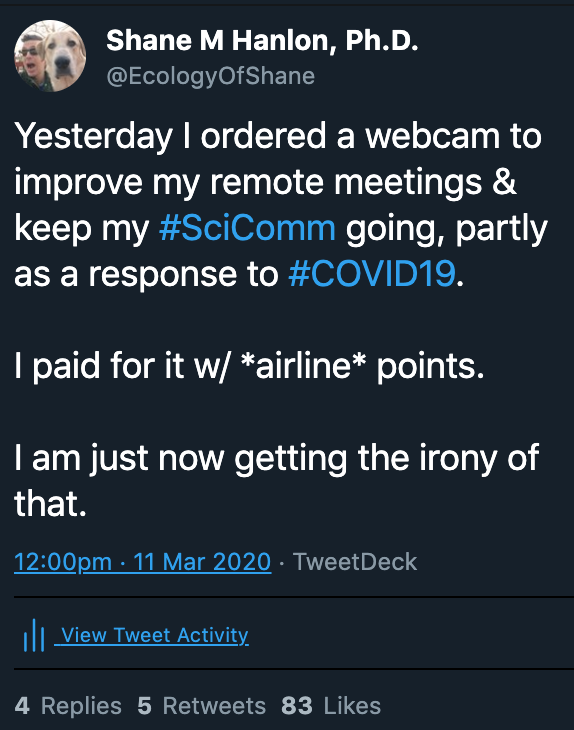16 March 2020
The value of face-to-face virtual meetings for scicomm (& more)
Posted by Shane Hanlon
By Shane M Hanlon
I’ve been thinking about this for a while, not just because of COVID-19 and the events around the world (including here at AGU) being cancelled and/or moved to online only, but because we live in a world that is constantly connected. Workplaces are set up for virtual work. Folks telework more and more. I personally attend a ton of meetings over the phone. However, I’ll be the first one to admit that if I’m participating in a meeting via phone, my attention is not 100%* on the subject at hand. For me, this was a feature, not a bug. For the longest time I loved attending meetings via phone because that meant I could focus on other things as well as the task at hand. But then I attended a multi-day meeting remotely, and, to my surprise…I loved it!

Sad Tacoma wants to play. Credit: Me
Last year I was a Community Engagement Fellow with the Center for Scientific Collaboration and Community Engagement. Basically, we’re a community of scientific community managers. The fellowship was a fantastic year of learning and camaraderie, and when the year-end wrap-up came, there was a cohort of us who couldn’t attend remotely. So, virtual options were provided.
Given my past record with remote attendance, I was not optimistic. But, it was the option so I went with it. Immediately I knew it would be different. First off, there was no “call-in only” option. This was three full days of presentations and workshopping – we were expected to be at our computers projecting video. So, I set myself up in my home office, threw on my noise-cancelling headphones (much to the annoyance of my dog) and dove in. And yano what? It worked. Like, really, really well. Some things that helped the process:
- Side messaging channel: We’re all on Slack and had a side channel set up for remote folks. Anyone at the meeting could see it so it’s not like we were talking smack or goofing off – it was just a good place to check in in case someone missed something or wanted to share some remote-related info.

- Channel facilitator: We had a dedicated person who was responsible for making sure that we had all the info that we needed and kept us on track. They were much more than just a note taking and disseminator and their role was vital.
- Silliness: Since we were located all over the world, we shared the stuff that was going on in our locations. From pets (see above), to children, to randomness happening outside our home offices (or hotel rooms), sharing the personal kept things engaging.
- Directed questions: The folks in the room and facilitator on the channel made sure we were included by making sure we were included. Folks were made aware that they’d be responsible for sharing at certain sections (no surprises) and engaged just like those in the room.

Yes this happened. Credit: Me
I realize that this is a special situation where long-term participation was required (so this experience might be helpful for many of our new realities) but I think that remote face-to-face meetings of smaller groups and shorter length should also be the standard. I honestly haven’t implemented this practice yet but plan to. I’m a convert.
–Shane M Hanlon is the Program Manager for AGU’s Sharing Science Program. Find him @EcologyOfShane.
*In all fairness, this happen at in-person meetings, thought the percentage is much smaller.


 The Plainspoken Scientist is the science communication blog of AGU’s Sharing Science program. With this blog, we wish to showcase creative and effective science communication via multiple mediums and modes.
The Plainspoken Scientist is the science communication blog of AGU’s Sharing Science program. With this blog, we wish to showcase creative and effective science communication via multiple mediums and modes.